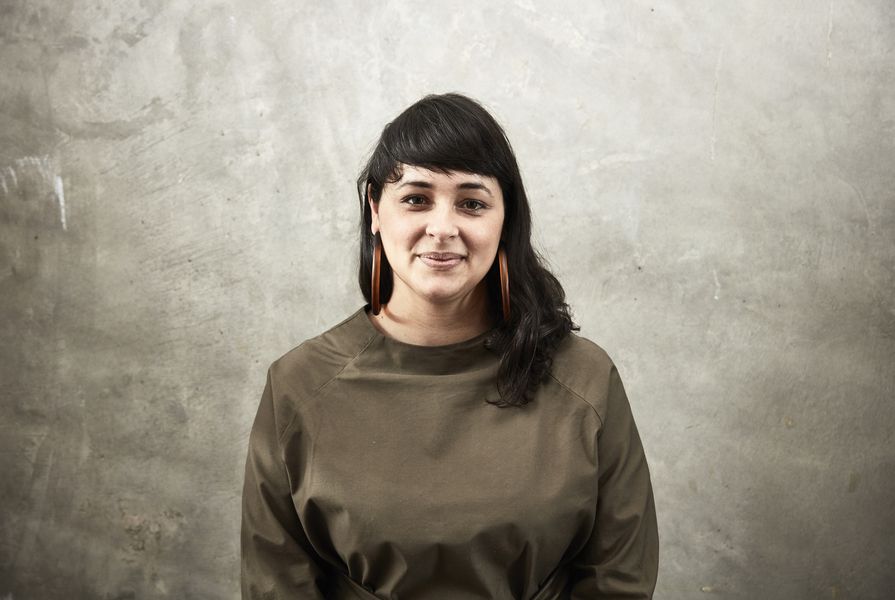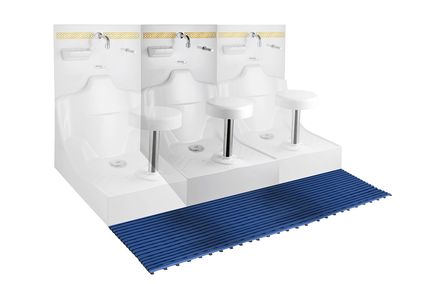Kennedy Nolan’s director of architecture, Adriana Hanna is a self-confessed furniture fanatic. She understands the value of quality furniture and its ability to enhance the visual appeal of a built form. Here, she shares the top five furniture pieces that have left memorable impressions on her.
An artisan-made theme recurs throughout, with many of her chosen pieces bearing a resemblance to 20th-century architectural structures. Each furnishing is a celebration of craftsmanship – emphasizing an appreciation for the skill and dedication required to handmake an item. For Adriana, the charm of each work transcends the physical. Every piece is a considered reflection of history and culture, and has a rich and meaningful narrative behind it.
This selection of eclectic objects also offers a glimpse into Kennedy Nolan’s distinctive design language and the creative influences driving their projects.
Tokyo daybed by Charlotte Perriand for Cassina
Adriana Hanna’s Tokyo daybed by Charlotte Perriand for Cassina.
Image: Supplied
The Tokyo daybed is a piece steeped in history. Crafted from bamboo by French designer Charlotte Perriand, a long-time collaborator with Le Corbusier, during a visit to Japan in 1940. The piece came as an innovative reimagining of Le Corbusier’s LC4 Chaise Lounge, created in 1928 for Cassina. The recliner is composed of 12 curved strips of wood joined together by brass studs. An accentuated arch has been designed to mould around the curves and contours of the body. A versatile piece, it can be a feature in an indoor or outdoor setting.
Adriana, a fervent admirer of Perriand and her works, managed to snap up the piece at a secondhand auction. “It is an iconic piece in the sense that it was designed by Charlotte Perriand, whose career is extraordinary. First, she mastered the machine-age aesthetic through her design of chrome and steel furniture, then she spent time in Japan and learned how to work with bamboo and its properties, [after which] she designed the Tokyo daybed and released it under her own name,” she said.
Perriand was a pioneer in her field during a time when female designers were scarcely recognized, but this did not come without its obstacles, including not being credited for her works at Le Corbusier, an omission that has now been rectified by Cassina – the company that distributes the range today.
Working at Le Corbusier’s studio, she often found herself – as did many female designers of the era – overshadowed by male colleagues. “But she persevered and created her own version of the LC4 daybed that was far superior to the original and I think that’s what makes the piece even more special,” Adriana said.
“I admire every piece that she made, but this would be top of the list for me, as she was at the peak of her career. She was exploring materiality, she was influenced by a culture and a place and there’s just a wonderful kind of history to it. In a physical sense, the materiality and the tactility is just remarkable. It’s a form, it’s sculptural and it’s comfortable. It’s an enduring piece of design.”
Akari Light Sculptures by Isamu Noguchi
Akari Light Sculpture by Isamu Noguchi, integrated in Adriana Hanna’s house.
Image: Supplied
For Adriana, the beauty of Noguchi’s avant-garde light sculptures lies in their form. The ethereal lamps take on a variety of expressions, ranging from organic and nature-inspired shapes to eccentric architectural and geometric arrangements.
During a visit to Gifu, Japan, in 1951, Noguchi studied the traditional Japanese lantern-making process with great fascination. Making the decision to revive the dying art form, he began creating his own lanterns in unconventional shapes using washi paper and bamboo. Crafted by hand, the process involves stretching thin bamboo ribbing across a wooden sculpture designed by Noguchi. Strips of washi paper are then cut, pasted to both sides of the sculptural framework and left to dry. Once dry, the shape is then set. The internal wooden form is then disassembled and removed, resulting in a lantern form that can be collapsed.
Adriana fondly recalled a quote from Noguchi in which he expressed that the process was like “carving the light,” a phrase that she referred to as being both “poetic and beautiful.”
With such an assortment of marvellous shapes to choose from, Adriana said it’s impossible to nominate just one as her favourite. She attributed her adoration of the lamps to them being a functional work of art.
“At times I will refuse to turn on any other lights and I’ll just turn the Akari lights on and just let the room be filled with their soft, ambient light,” she said.
Nuvola Armchair by Hannes Peer for Spotti Edizioni Milano (SEM)
Not just a display feature, the Nuvola Armchair by Hannes Peer for Spotti Edizioni Milano (SEM) is the perfect place to sink into.
Image: Courtesy of Spotti Edizioni Milano (SEM)
“I first saw this beautiful piece in a magazine, the chair was pictured in Hannes’s apartment, but then I had the opportunity to meet him in Milan last year at his studio and actually got to sit in it,” Adriana said.
“It’s a wonderful ode to the historic pieces of Brazilian furniture. It’s very contemporary in the way it’s detailed with plywood and steel on the back but the leatherwork is really a nod to the original makers of the Brazilian Safari armchairs. What I love is that while it’s a contemporary piece, it still manages to create this feeling as if it could have been designed 50 years ago.”
Lacquered iron, brass and wood veneer are sophisticated accompaniments to the leather and fabric upholsteries. Not just a display feature, the armchair is the perfect place to sink into.
“It has been crafted from a really beautiful mix of materials. There is really fine, elegant detailing across the back,” she said. “You definitely want to lounge in it. This is not a waiting room piece. It’s very comfortable and has a very generous width, as well. Some of the historical Brazilian pieces were not as generous and often a little bit narrower and I believe he’s taken cues from that design and tried to improve and evolve from that.
“To me, Hannes Peer is one of the more exceptional and exciting designers of this generation. He’s really bringing back that attention to detail and quality craftsmanship, which is often overlooked in modern design. His other pieces are also extraordinary, but that is a standout for me.”
Prue Cabinet by Khai Liew and Prue Venables
Prue Cabinet by Khai Liew and Prue Venables.
Image: Grant Hancock
The Prue Cabinet reintroduces Australians to a moment in history. Resembling the composition of a meat safe, albeit a high-end meat safe, the crafted wooden form acts as a symbol of Australian culture and historical way of living.
Furniture designer-maker Khai Liew collaborated with ceramicist Prue Venables to create a unique rendition of the classic piece. Exquisite ceramic details integrated into the wood, reference the ventilation points on the traditional food storage cupboards. Adriana admires the modern and ornamental interpretation of a design rooted in history, and the juxtaposition between old and new.
“I adore all of Khai Liew’s pieces, he is probably my favourite designer of Australian furniture, but this piece in particular and the story behind it just feels very Australian and very special,” Adriana said. “I first saw it at the 2015 Rigg Design Prize at the National Gallery of Victoria. It’s possible that only one Prue Cabinet was produced as many of his pieces are one-off commissions for clients.”
Adriana finds the incorporation of the narrative and the thorough investigation required to embed the concept into the cabinet enhances its appeal. Additionally, the individuality and customization of each piece as a one-off commission further adds to the allure.
“Something that I really enjoy about his work and his studio is that they frequently use local materials when crafting their pieces,” she said.
Oblique Ceramic Coffee Table by Don Cameron
Oblique Ceramic Coffee Table by Don Cameron, as featured in Sydney’s Gallery Sally Dan-Cuthbert.
Image: Courtesy of Gallery Sally Dan-Cuthbert
The modernist references to brutalist architecture, combined with the tactile and textured quality, give the ceramic composition an architectural feel.
During a recent Melbourne Design Week event, the robust table caught her eye. “It reminds me a bit of Jørn Utzon’s work. It’s very much of another era. We haven’t seen many contemporary ceramic pieces produced locally in this way. This table has taken time and consideration. It’s very three-dimensional and dynamic,” Adriana said.
“As much as I adore timber, I think ceramic is much more of a tactile material. There’s definitely an element of the handmade when it comes to ceramics, in terms of the glazing, forming and firing. There are so many layers of detail that go into creating ceramics and I always admire the craftsmanship behind the finished object or product. There’s something about ceramics that gives the impression it would withstand several lifetimes,” she continued.
“Kennedy Nolan as an architecture firm is drawn to modernist references, we’re really attracted to 20th-century design. We actively try to integrate ceramics into our architectural works through materials such as Japanese ceramic tiles.
“What’s intriguing with all these pieces is that there is perpetuity in them. They possess a timeless quality and could be handed down for generations. They’re not something you’d tire of.”































